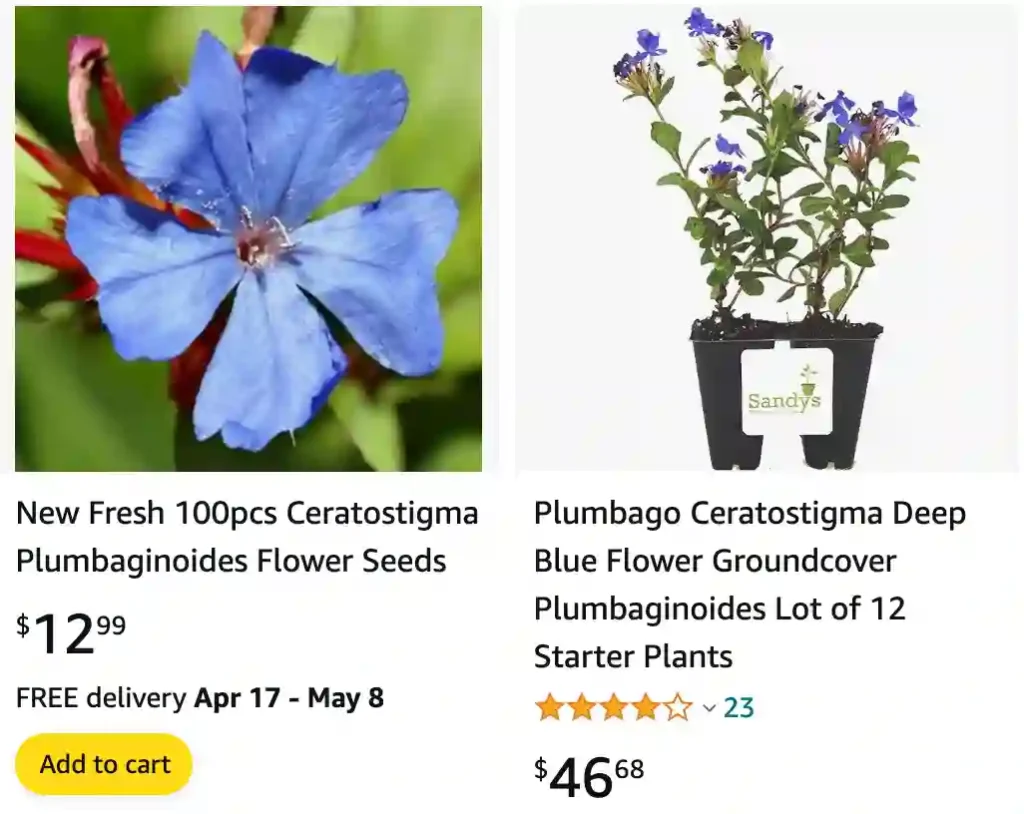
Introduction: Embracing the Beauty of Ceratostigma Plumbaginoides
As an avid gardener, I’ve always sought out unique and resilient plants to adorn my green haven. One such gem that has captivated my attention is Ceratostigma plumbaginoides, affectionately known as the blue-flowered leadwort. In this narrative, I’ll share my personal experiences, discoveries, and reflections on cultivating this hardy perennial, allowing its vibrant blue blooms to weave tales of color and resilience in my garden.
Unveiling the Beauty: Ceratostigma Plumbaginoides in Detail
Ceratostigma plumbaginoides, hailing from the plumbago family, graces us with its presence in the rocky foothills of Western China. Standing at a modest 50 cm, it forms a captivating mat with ovoid leaves that may transition to shades of red or purple before gracefully falling. Late summer and early autumn witness the grandeur of its bright blue flowers, creating a spectacle that’s hard to ignore.

Discovering Resilience in My Garden: Cultivation and Characteristics
According to my actual experience, cultivating Ceratostigma plumbaginoides has been a rewarding journey. Thriving as an ornamental plant in temperate climates, it boasts resilience down to -10 °C (14 °F). However, my experimentation with its placement has revealed that it thrives best in a sunny, sheltered position within moist, well-drained soil.
As I embarked on this horticultural adventure, I learned that this leadwort, though resilient, can become invasive. Hence, I found the perfect solution by opting to grow it in a pot or nestled within the crevices of a dry stone wall. This not only contained its exuberance but also added a touch of elegance to these unconventional planting spaces. No wonder it has earned the Royal Horticultural Society’s prestigious Award of Garden Merit.
Etymology: Decoding the Intriguing Name
Delving into the etymology of Ceratostigma unveils its Greek roots, where ‘horned stigma’ becomes a poetic descriptor of the shape of its stigmatic surface. This linguistic connection adds a layer of fascination to the plant, turning it into more than just a species in my garden but a living, breathing entity with a rich history.
Cultivating Ceratostigma Plumbaginoides: A Personal Perspective
In my personal gardening experience, I’ve found Ceratostigma plumbaginoides to be an easily adaptable companion. It effortlessly thrives in average, medium, well-drained soils, showcasing its versatility in various garden settings. The somewhat wide range of soil tolerance, except for excessively wet conditions, allows me to experiment with its placement, adding an element of surprise to my landscape.
Witnessing Nature’s Canvas: Noteworthy Characteristics of Plumbago
As I observed the growth of Ceratostigma plumbaginoides in my garden, I marveled at its wiry, mat-forming nature. The plant’s ability to spread by rhizomes, forming an enchanting ground cover, became a defining feature of my landscape. The transition of its medium green leaves to a captivating bronze-red in autumn adds a painterly touch, harmonizing with the gentian blue flowers that bloom from summer to frost.
The genus name, rooted in Greek, with ‘keras’ signifying a horn and ‘stigma’ representing the hornlike projection on the flower’s stigma, further deepens the connection I feel with this botanical companion.
Overcoming Challenges: Problems and Solutions
My journey with Ceratostigma plumbaginoides hasn’t been without challenges, albeit minor. While it encounters no serious insect or disease problems, its propensity to spread has prompted me to exercise caution. This, however, is a small price to pay for the late, long-flowering spectacle it brings to my garden.
Unlocking the Potential: Practical Uses in Landscaping
Embracing Ceratostigma plumbaginoides as a late, long-flowering ground cover has been a game-changer in my landscaping endeavors. From underplanting for shrubs to serving as an edger or a striking addition to rock gardens, its versatility knows no bounds. The plant’s unique ability to inhibit weed growth adds a layer of practicality, making it not just a visual delight but a functional component of my garden ecosystem.
A Symphony of Colors: Description and Aesthetic Appeal
Award-winning Plumbago, as I affectionately call it, weaves a tapestry of colors in my garden. Its low, horizontal spread and herbaceous perennial nature create a visual treat. The juxtaposition of bronze-red fall foliage against the sky blue flowers evokes a sense of wonder and admiration. Standing at 6 to 8 inches tall, it effortlessly fills the void left by spent perennials, becoming a reliable ‘spiller’ in my container arrangements.
Balancing Act: Navigating Challenges and Enjoying Rewards
Like any garden companion, Ceratostigma plumbaginoides comes with its share of considerations. The occasional powdery mildew and the presence of Citrus mealybug require attention, but the joy it brings far outweighs these minor inconveniences.
A word of caution: contact with this plant can lead to dermatitis, a lesson I learned firsthand. Protective gloves are now a staple in my gardening toolkit when pruning or tending to my vibrant leadwort.
Harmony in Diversity: Adapting to Different Climates
As a testament to its adaptability, Plumbago thrives in sandy and loamy soils. Its preference for well-drained, slightly moist soil allows it to flourish even in nutritionally poor conditions. While it basks in full sun or partial shade, a touch of afternoon shade in hot climates ensures its well-being. In my gardening experiments, I’ve discovered that it cannot tolerate full shade but, interestingly, can withstand cooler climates with the help of a light winter mulch.
Conclusion: Ceratostigma Plumbaginoides – A Tale of Endurance and Beauty
In the tapestry of my garden, Ceratostigma plumbaginoides stands out as a testament to endurance and beauty. Its journey from the rocky foothills of Western China to the heart of my garden is a narrative of resilience, adaptability, and the harmonious dance of colors. As I continue to nurture and explore the nuances of this captivating perennial, I find myself immersed in a story written not in ink but in leaves, flowers, and the ever-changing seasons of my botanical haven.



